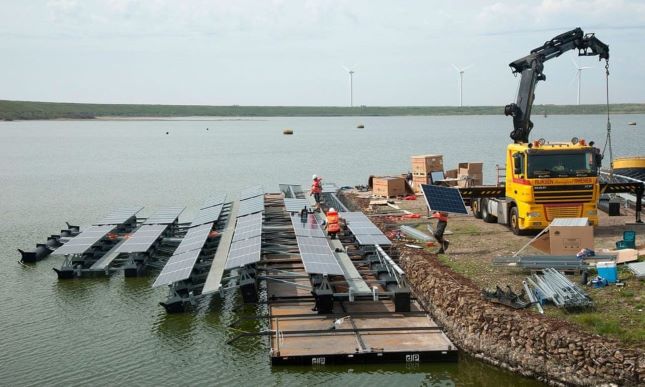

Dutch engineers are building what will be the world’s largest archipelago of islands made up of sun-tracking solar panels. Silencing the resistance of the locals over the construction of wind turbines or large ground mount structures, making floating solar farms the next best alternative. Currently, large islands of solar panels are under construction or already in place in reservoirs and lakes across the Netherlands, China, the UK and Japan.
After completion this will become the largest of its type in the world, construction will begin this year on 15 solar islands on the Andijk reservoir in north Holland. The islands, containing 73,500 panels, will have the sunflower-like ability to move to face the light.
The first phase of the project, involving three islands, each of which will be 140 metres in diameter, is due to be finished by November, once the migratory season for birds has come to an end.
Arnoud van Druten, the managing director of Floating Solar, a solar panel supplier, said: “The sun-tracking system involves three buoys for anchoring with cable around it, which turns the island and at the same time keeps the island together. It ensures the island is turned towards the sun.
[related_post]
“You can have two options: one is tracking automatically to the light. But because the position of the sun is not expected to change too much in the coming years, an algorithm can be easily programmed.”
A second project will be at Hoofddorp, near Amsterdam, and will involve static solar panels, the water company PWN, which owns the land on which the farms will be located, is expected to create enough energy to power 10,000 households.
Another added feature of the islands is that they can reposition themselves in extreme weather to minimise damage.
“Andijk is a very severe environment,” Van Druten said. “So we have optimal solar tracking, which is generating extra energy, and weather risk management [WRM], which is a technology that makes sure that if an island is under severe pressure due to wind or storms, it moves itself automatically in a position so the wind and waves travel easily through the island. We have already tested that the system can sustain, without WRM, wind speeds of around 60mph.”
Van Druten further explains, “Our design has the least impact on the ecosystem as possible so the water quality remains almost the same. At the same time, because the island is moving, we don’t have a fixed shadow shape.”
To avoid damaging the reservoir’s ecosystems, half its surface area will be covered by the islands. The added benefit of floating solar panels is that the water will also cool the electrical wiring.
1. The mandate for blending Compressed Biogas (CBG) with natural gas has come into effect…
Andhra Pradesh is striving towards greening its energy sector with quite some speed. In a…
With an objective to bolster India’s green energy goals, a Tripartite Agreement has been signed…
The Union MNRE Minister Pralhad Joshi launched the Green Hydrogen Certification Scheme of India (GHCI)…
India’s energy conglomerate Bharat Petroleum Corporation Limited (BPCL) has commissioned a 5MW green hydrogen plant…
In a historical development, the European Space Agency (ESA) has successfully launched its pioneering ‘Biomass’…